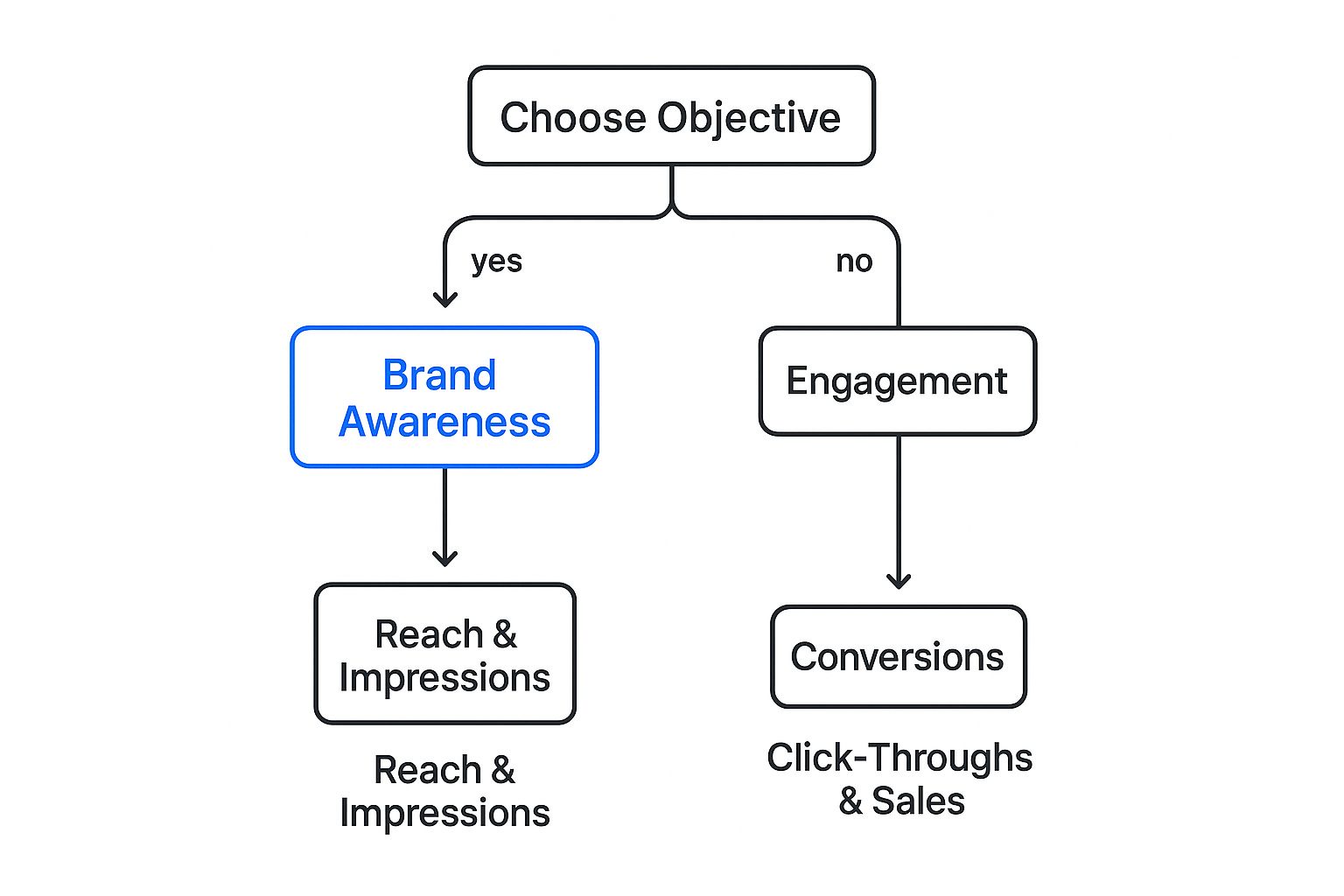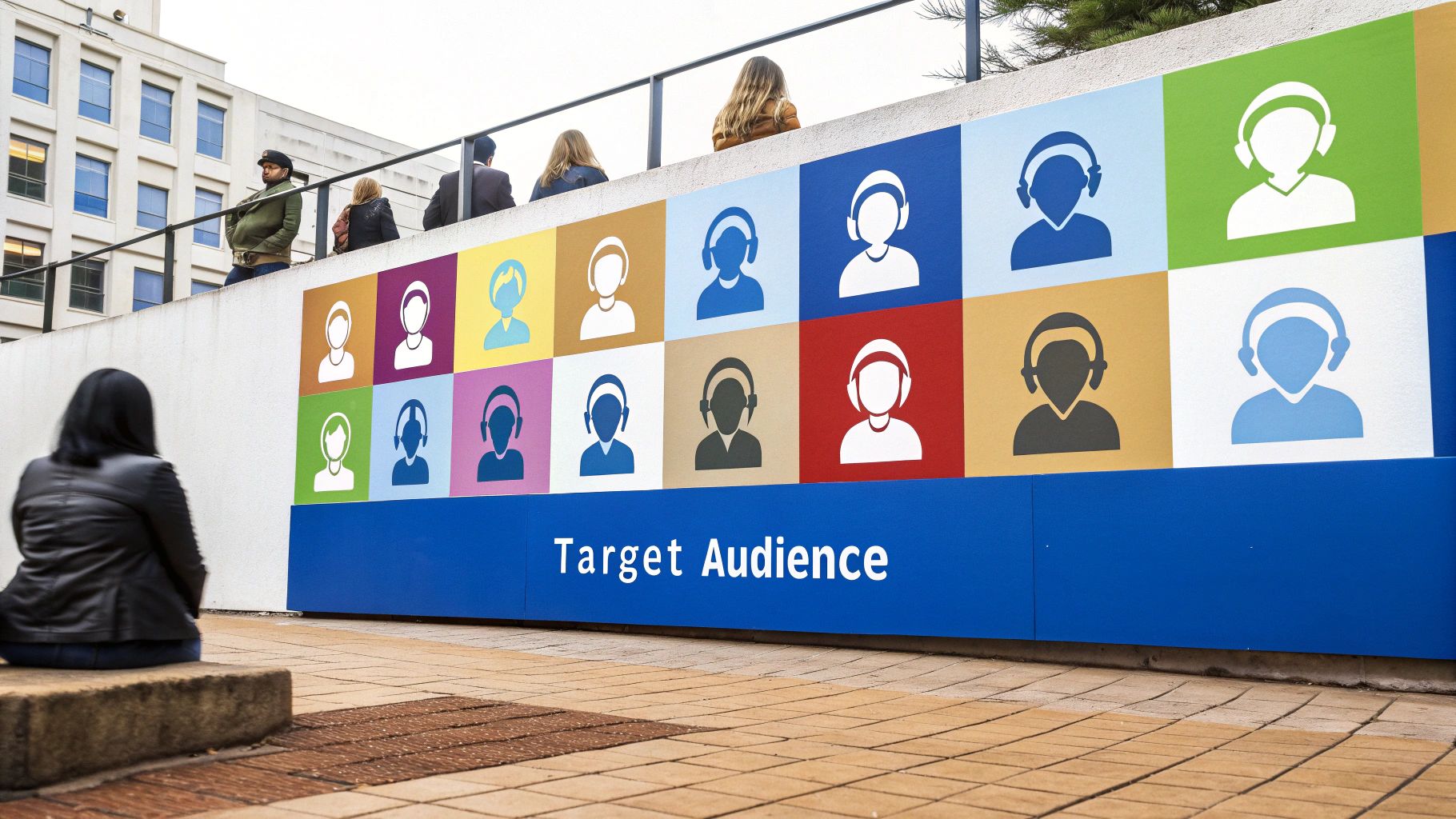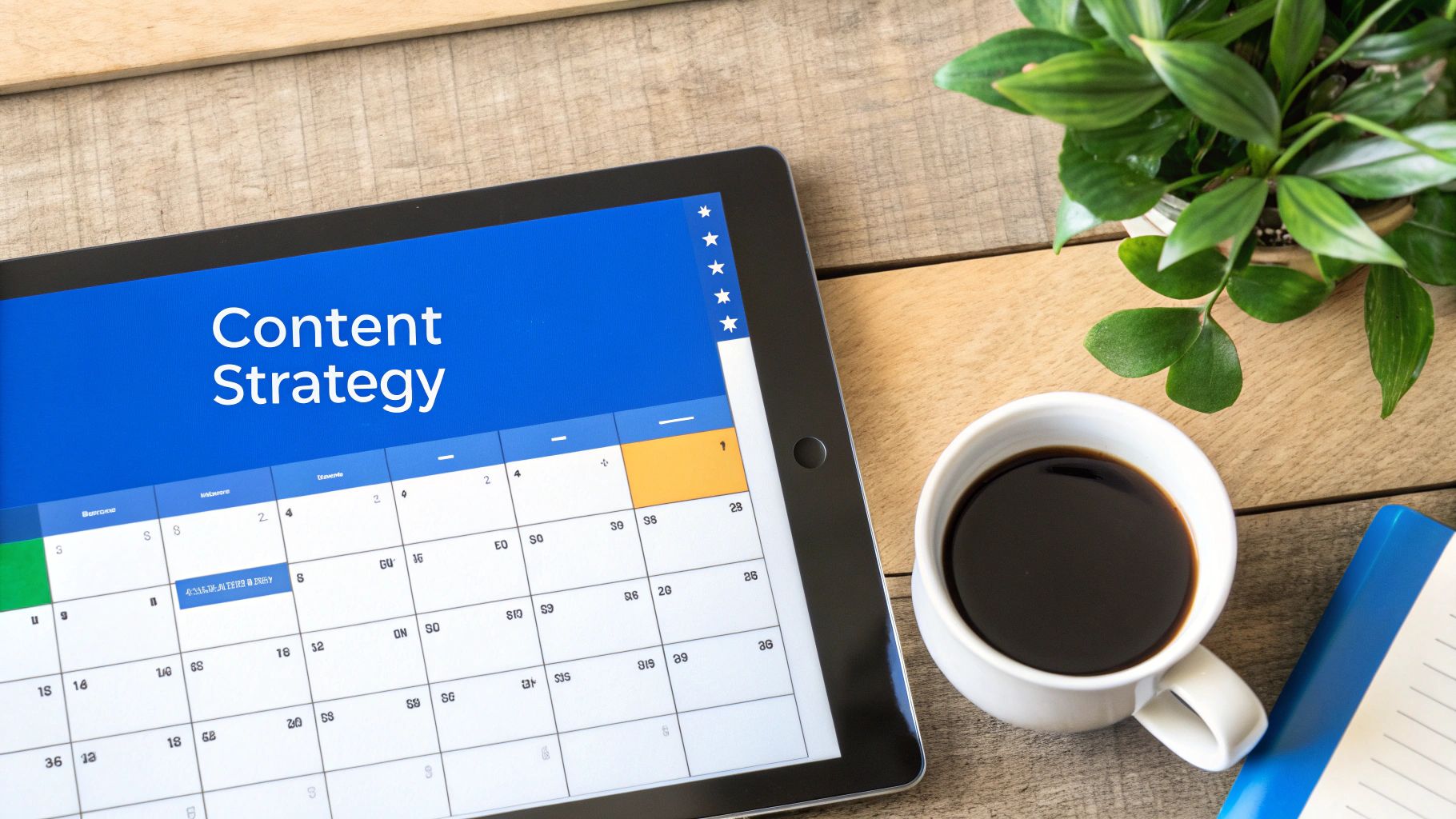Any solid social media marketing plan starts with a good, hard look in the mirror. Before you dream up clever campaigns or design beautiful graphics, you have to get your hands dirty with a bit of intelligence gathering. This initial step is all about understanding where you stand right now so you can figure out where to go next.
Building Your Foundation for Social Media Growth

Jumping into content creation without this groundwork is like starting a road trip with no map and half a tank of gas. You might move, but you won't get where you want to go. To build a strategy that actually works, you need to start with a social media audit to see what's connecting with your audience and what's just taking up space.
This isn't just busywork. It’s a real, practical look at your current social media efforts. You're hunting for patterns in your most successful content, spotting neglected platforms, and ensuring your brand's voice is consistent across the board.
Conduct a Practical Social Media Audit
First things first, make a list of every social media profile you have—yes, even that dusty old one you haven't touched in a year. For each account, ask yourself some honest questions:
- What's actually working? Pinpoint your top three posts from the last 90 days. What do they share? Was it the video format, the carousel style, the topic, or the conversational tone?
- Who is listening? Dig into the demographics of your followers on each network. Is this the audience you want to reach, or are you talking to the wrong crowd?
- Where are the holes? Is your ideal customer hanging out on a platform where you're a ghost? Are your profile bios, links, and contact info all current and optimized?
Getting answers here gives you a clear baseline. You might find that your Instagram Reels get 5x the engagement of your single-image posts. That's not just a fun fact; it's a bright, flashing sign telling you where to point your efforts.
Pro Tip: So many people treat an audit as a one-and-done project. Don't make that mistake. A quick monthly check-in keeps your strategy fresh and aligned with what your audience is actually responding to.
Analyze Competitors to Find Your Opening
With your own house in order, it's time to peek over the fence at your competitors. The goal isn't to copy them—it's to find the gaps they've left wide open. Choose two or three of your closest competitors and do a deep dive into their social media game.
You're looking for their weaknesses. Maybe your biggest rival owns the conversation on Facebook but is practically invisible on LinkedIn, where your B2B audience lives and breathes. That’s your opening. If you see they’re only ever posting "buy now" content, you have a golden opportunity to become the go-to expert by sharing genuinely helpful or entertaining posts.
This foundational research ensures your entire social media plan is built on solid ground, not just wishful thinking. The payoff is huge; research shows 80% of marketers credit social media with increased exposure, while 73% see more website traffic and 65% generate more leads. But remember, it's all built on trust—something that can be fragile when only 68% of U.S. users view Facebook favorably and just 43% feel the same about TikTok. You can dive deeper into these social media statistics to get a better sense of the landscape.
Of course. Here is the rewritten section, designed to sound completely human-written and natural.
Setting Goals That Actually Move the Needle
Let's be honest: vague goals like "get more followers" are a recipe for wasted time and fuzzy results. If you want a social media plan that makes a real difference to your business, you have to get specific. Your objectives need to tie directly back to what matters most—your bottom line.
Forget about chasing likes. Instead, think about what drives real business growth. A much stronger goal, for instance, would be to "boost qualified leads from LinkedIn by 15% this quarter." See the difference? We've gone from a vanity metric to a tangible business outcome.
A goal isn't really a goal unless you can measure it. The best way I’ve found to sharpen these objectives is using the SMART framework: Specific, Measurable, Attainable, Relevant, and Time-bound. It’s a classic for a reason—it forces you to turn ambiguous wishes into concrete targets you can actually hit.
This level of focus is critical when you remember just how massive the social media world is. We're talking about an estimated 5.42 billion users globally and a social ad spend of $276.7 billion. Without clear goals, you're just shouting into the void. Your goals are what ensure your slice of that investment brings back a real return. You can dig deeper into these social media insights on sproutsocial.com if you're a data nerd like me.
Figure Out Who You're Really Talking To
Once your goals are locked in, the next step is to get crystal clear on who you’re trying to reach. A surface-level "we're targeting millennials" just won't cut it. You need to build out detailed buyer personas, which are essentially character sketches of your ideal customers.
And I mean really get into the details, going way beyond the basic demographics. Sure, age, location, and job title are a starting point, but the gold is in understanding what makes them tick.
- Pain Points: What are the nagging problems that keep them up at night? What are their biggest headaches when it comes to your industry?
- Motivations: What are their aspirations? What does a "win" look like for them, and how can you be the one to help them get there?
- Online Hangouts: Where do they actually spend their digital downtime? Are they networking on LinkedIn, getting inspired on Pinterest, or watching quick-hit videos on TikTok?
Knowing this stuff is the secret sauce to creating content that doesn't just get seen, but gets felt.
Putting Your Persona to Work
Let's walk through a quick example. Imagine you're a B2B software company, and your target is marketing managers at mid-sized tech companies.
A lazy persona might just be: "Maria, 35, Marketing Manager." That tells you almost nothing.
A truly useful persona, one you can build a strategy around, looks more like this: Persona Name: "Stretched-Thin Sarah" Job: Marketing Manager at a 150-person tech company. Pain Points: She's drowning in manual reporting, constantly has to justify ROI to her CMO, and feels like she never has enough time to manage all the social platforms effectively. Goals: She’s desperately looking for ways to automate repetitive tasks, find tools that give her time back, and deliver reports that make her look like a rockstar. Channels: She lives on LinkedIn for industry news and follows a few key influencers on X (formerly Twitter) for quick takes.
Boom. Suddenly, your path is clear. You know you need to be on LinkedIn and X. You know you should be creating content that solves her specific problems, like a guide on "5 Ways to Automate Your Social Media Reporting." This is how you build a social media marketing plan around a real person, not just a demographic.
Alright, you've got your goals locked in and you know exactly who you're talking to. Now comes the fun part: deciding where to plant your flag in the social media world and what you're actually going to talk about.
One of the biggest blunders I see brands make is what I call the "spray and pray" approach—trying to be on every single platform. This just stretches your resources thin and turns your message into faint background noise. A killer social media plan isn't about being everywhere; it's about being in the right places, consistently.
The secret? Go where your customers already are. If you’re a B2B consultant aiming to build authority, your home base is LinkedIn, where professionals are actively looking for solutions. Selling handcrafted jewelry? The visual, aspirational worlds of Instagram and Pinterest are your natural habitats. Each platform has its own vibe and unwritten rules. Success means playing by them.
Selecting the Right Social Channels
Resist the temptation to just pick the platforms with the most users. Instead, think back to your ideal customer. Where does "Stretched-Thin Sarah," our persona from earlier, go to unwind, get inspired, or find answers to her business problems?
Here’s a simple checklist I run through with my clients:
- Audience Demographics: Does the platform’s user base actually match your buyer persona? Don't guess—look at the data.
- Content Format: Does the platform lean into content you can create well? If you shine in short-form video, TikTok or Reels are obvious choices. If you’re great with long-form text, maybe Medium or LinkedIn articles are a better fit.
- Business Goals: How will being on this platform help you hit your targets? Is it built for generating leads, fostering a community, or just getting your name out there?
This isn't just about picking a channel; it's about matching its function to your goals. The flowchart below does a great job of visualizing this connection.

As you can see, if your main objective is brand awareness, you need platforms that are masters of reach and impressions. If it’s lead generation, you’ll want to focus elsewhere.
To help you put this into practice, here’s a framework I use to guide this decision.
Platform Selection Framework
Use this table as a quick reference to align your audience, content style, and business objectives with the most suitable platforms.
| Platform | Primary Audience | Best For (Content Type) | Key Business Goal |
|---|---|---|---|
| Millennials & Gen Z | High-quality visuals, video (Reels), Stories | Brand Awareness, Community Building | |
| Gen X & Millennials | Diverse content, community groups, ads | Community Building, Lead Generation | |
| Professionals, B2B | Long-form posts, articles, case studies | B2B Lead Gen, Thought Leadership | |
| TikTok | Gen Z & Younger Millennials | Short-form, entertaining video | Viral Reach, Brand Awareness |
| Millennial Women | Inspirational images, infographics, guides | Driving Traffic, Product Discovery | |
| X (Twitter) | Broad, News-focused | Real-time updates, conversations, quick tips | Customer Service, Brand Voice |
This table isn't exhaustive, but it's a solid starting point for making a strategic choice instead of just following the crowd.
Building Your Core Content Pillars
Once you’ve chosen your battlegrounds, it’s time to decide what you’ll talk about. This is where content pillars come in. Think of these as three to five core themes that anchor your entire content strategy. They ensure every post is on-brand and genuinely valuable to your audience.
Your pillars should sit at the intersection of what your audience cares about and what your brand authentically represents.
For instance, a sustainable fashion brand might build its strategy on these pillars:
- Ethical Production: Behind-the-scenes looks at the factory, artisan spotlights, and material sourcing stories.
- Style Inspiration: User-generated content, "how to style" videos, and lookbooks.
- Conscious Living: Tips on mending clothes, reducing waste, or other topics that align with their audience's values.
Here's a pro tip: Don't make all your pillars about your product. The best strategies focus on solving your audience's problems or speaking to their interests. Your product then becomes a natural part of that conversation, not a constant sales pitch.
These pillars are your North Star. They simplify content planning, prevent you from ever asking "What should I post today?", and ensure your brand tells a cohesive story. To get the most mileage out of your ideas, look into strategies for repurposing content for social media. This will help you turn one great idea into a dozen different posts tailored for each channel, saving you a ton of time and effort.
A Look Inside a Real Social Media Marketing Plan

It’s one thing to talk about strategy, but it’s another to see it laid out. Let’s put all this theory into practice. I've created a social media plan for a fictional e-commerce brand I’m calling “Grove & Loom,” which specializes in handcrafted, sustainable home goods.
This isn't just a generic template. It's a practical, filled-in example showing how all the pieces—from high-level goals to daily posts—connect. We'll walk through it section by section, and I'll explain the thinking behind each choice.
Executive Summary
Our core mission for Grove & Loom is to build a vibrant community of ethically-conscious consumers on Instagram, Pinterest, and Facebook. The strategy will lean heavily on visual storytelling—think high-quality video and authentic user-generated content (UGC). We want to move beyond just showing off products and instead highlight our deep commitment to sustainable craftsmanship.
Over the next six months, our main objective is to increase website traffic from social media by 25%. At the same time, we're aiming to lift our conversion rate from those social referrals by 15%. We'll get there by establishing our brand as the go-to source for sustainable living inspiration.
SMART Goals
Here’s where we get specific. Vague goals like "get more followers" don't cut it. We need concrete, measurable targets to know if what we're doing is actually working.
- Brand Awareness: We will increase our Instagram post reach by 30% and grow our follower count by 20% this quarter. The plan is to post five high-quality Reels each week and collaborate with two micro-influencers in the sustainable living space.
- Engagement: Our goal is to double our average engagement rate on Pinterest from 1.5% to 3% within six months. To do this, we'll create and promote 10 new Idea Pins monthly, focusing on practical "how-to" and DIY home decor guides.
- Conversions: The target is to drive 500 qualified leads per month to our "New Arrivals" page using Facebook ads. We need to maintain a click-through rate (CTR) of at least 2% while keeping the cost per lead (CPL) under $5.
Setting clear targets like these transforms a fuzzy wish list into an actionable roadmap. Each goal is tied to a specific metric, a target number, and a deadline, making it simple to track our progress and adjust as needed.
Platform-Specific Tactics
Spraying the same content across every platform is a rookie mistake. A much smarter approach is to tailor your content to fit the unique vibe of each network. You have to speak the language of the platform.
Instagram Strategy
Instagram is where we'll tell our brand story and foster our community. It’s all about aesthetics and authenticity here.
- Content Focus: We'll share behind-the-scenes Reels of our artisans, beautiful carousel posts with styled product shots, and weekly Instagram Stories featuring customer testimonials and UGC.
- Key Tactic: We will run a quarterly UGC campaign with the hashtag #MyGroveAndLoom. The best submission wins a $200 gift card, which should motivate our customers to share stunning, high-quality photos.
Pinterest Strategy
People use Pinterest to find inspiration and plan future buys. Our content needs to be genuinely helpful and visually compelling.
- Content Focus: We'll design detailed infographics for topics like "Sustainable Home Swaps" and "How to Care for Natural Wood." We’ll also produce short, inspiring video pins that showcase our products in beautiful, real-world home environments.
- Key Tactic: Every pin description will be optimized with relevant keywords like "eco-friendly decor" and "handmade furniture" to make sure we show up in search results on the platform.
Having a solid video strategy is crucial for making your social media efforts truly effective. If you want to dive deeper, this guide on building Your Winning Video Marketing Strategy is an excellent resource. You can also see our full, detailed https://postonce.to/blog/sample-social-media-marketing-plan for more examples you can borrow and adapt.
Measuring Your ROI and Optimizing for Performance
 Let's get one thing straight: your social media plan isn't a "set it and forget it" document. If you just file it away, you're missing the entire point. Think of it as a living, breathing guide that needs regular check-ups to make sure it’s actually working. This is where we separate the amateurs from the pros—by tracking what's happening and making smart, data-driven tweaks.
Let's get one thing straight: your social media plan isn't a "set it and forget it" document. If you just file it away, you're missing the entire point. Think of it as a living, breathing guide that needs regular check-ups to make sure it’s actually working. This is where we separate the amateurs from the pros—by tracking what's happening and making smart, data-driven tweaks.
Without measurement, you’re just throwing spaghetti at the wall and hoping something sticks. You might feel like a campaign is a hit, but the numbers tell the real story. This is how you confidently cut what isn't working and pour more fuel on the fire for what is.
Identifying Your Key Performance Indicators
First things first, you need to focus on the numbers that actually matter. Your key performance indicators (KPIs) should tie directly back to the SMART goals you established earlier. It's easy to get distracted by vanity metrics like follower count, but you need to prioritize metrics that show a real impact on your business.
Here are a few essential KPIs I always keep an eye on:
- Conversion Rate: This is the big one. It’s the percentage of people who take a desired action—like buying a product or signing up for a newsletter—after clicking a link in your post. It directly measures how persuasive your content is.
- Click-Through Rate (CTR): This tells you how many people who saw your post cared enough to click the link. A high CTR is a great sign that your creative and call-to-action are hitting the mark.
- Cost Per Lead (CPL): If you're putting money behind ads, this tells you exactly what you're paying to get one new lead. Keeping this number as low as possible is crucial for a profitable campaign.
A huge part of a successful marketing plan is knowing how to measure advertising effectiveness to prove your efforts are actually paying off. This is how you justify your budget and show the value you're bringing to the table.
Analyzing Your Data and Optimizing Your Plan
Tracking metrics is only half the job. The real magic happens when you dig into that data and use it to make better decisions. I recommend setting aside time every month or quarter to really dive into your analytics. Look for patterns and start asking the tough questions.
Did that new video series you launched actually send more traffic to your website? Did engagement dip when you started posting less on Fridays? These insights are pure gold.
Don’t be afraid to discover a campaign was a flop. A failed experiment gives you priceless data on what your audience doesn't want, which is just as useful as knowing what they do. Use those lessons to pivot.
When it comes to budgeting, costs can be all over the map. The average spend is about US$46.47 per social media user, but that figure can swing dramatically from US$335 in the United States to just 86 cents in Pakistan.
Continuously refining your strategy based on real-world data is the surest way to get the best possible return on your investment. For more hands-on advice for improving your day-to-day execution, you can find some great insights in our guide on essential social media management tips.
Common Questions About Social Media Planning
Even with a great plan in hand, putting it into action always brings up a few questions. I've heard them all over the years. Let’s walk through some of the most common hurdles people face when they move from planning to actually doing.
A big one is always about money: "How much should I actually budget for this?" While there's no single magic number that fits everyone, a solid rule of thumb I often recommend is the 50/30/20 rule.
Here’s how it breaks down:
- 50% of your budget goes to creating top-notch content—think video shoots, graphic design, and copywriting.
- 30% is for paid distribution, which means social media ads to get your content in front of the right people.
- 20% covers the essential tools and tech that make your life easier, like scheduling platforms or analytics software.
Another frequent concern is how to keep the plan from getting stale. Social media is always changing, so your plan needs to be flexible. Don't carve it in stone. I treat my plans like living documents, giving them a quick check-in every month and a much deeper review every quarter to make sure the strategy is still on point.
How Often Should I Post?
This is the million-dollar question, isn't it? The honest answer is: it depends entirely on the platform and what your audience expects. But here’s something I’ve learned from experience: consistency will always beat frequency.
It’s far better to publish three genuinely great posts a week that people love than to churn out seven forgettable ones just to hit a quota.
If you need a starting point, here are some general guidelines:
- Instagram: Aim for 3-5 times per week.
- Facebook: 1-2 times per day often works well.
- LinkedIn: Stick to 2-3 quality posts per week.
- X (Twitter): This platform moves fast, so 3-5 times per day is common.
Remember, the goal is quality engagement. One post that sparks a real conversation is worth more than a dozen that are met with silence. Keep an eye on your analytics to discover the posting rhythm that works for your audience.
What If I Run Out of Content Ideas?
Content block is a real thing. We've all been there. This is where your content pillars become your best friend. When you feel stuck, just go back to those core themes you defined in your plan.
Let's say one of your pillars is "Ethical Production." You could easily brainstorm a whole list of ideas from that single theme:
- Film a behind-the-scenes video tour of your workshop.
- Do a Q&A spotlight with one of your artisans.
- Create a simple infographic showing how you source your materials.
This method gives you a repeatable system for generating fresh, relevant ideas. You can also work smarter, not harder, by adapting your content for different channels. A smart strategy for social media cross-posting helps you repurpose one core piece of content for multiple platforms, which saves a ton of time and makes executing your plan so much easier.
Ready to stop copy-pasting and start growing? With PostOnce, you can create content once and let our smart automation distribute it perfectly across all your social networks. Save time, stay consistent, and amplify your reach without the manual effort. Start your free trial at PostOnce today